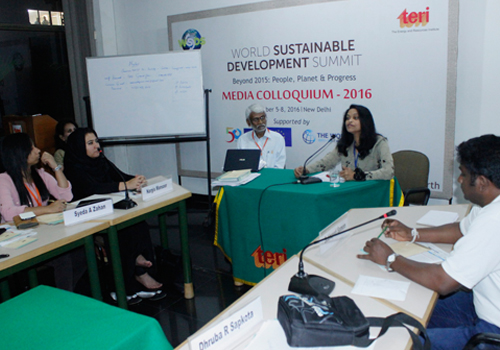
How to create news reports that grabs the reader
By Mir Farhat and Sharada Balasubramanian

Anita Pratap, the international journalist who has covered wars and crises, said that news reports should be humanised, with the facts right and written in simple language with no jargon to make readers want to read them.
Speaking on Thursday at Media Colloquium on "There Are No Boring Stories, Only Boring Story-tellers," she said, "When a story is written, people's emotions should be conveyed. The emotions should reflect sensitivity not sensationalize. Tell the people's version, not yours." This approach is important for stories that are heavy on statistics and complex information, said the former reporter for CNN, Time and India Today.
Two experts from Earth Science and Climate Change Division at TERI, Suruchi Bhadwal, the Associate Director, and Mihir Mathur, an Associate Fellow, also spoke at the colloquium about "Great Peril" from climate change.
Together, the two sessions complemented for journalists how to get the message of the dangers of the climate change across to the people - getting the facts and telling the story in a way that grabs the people.
"This is the most exciting time to do environmental journalism," Pratap said. "As journalists, it is important to know and love what you do, and have curiosity in pursuing stories."
"When a story is written, people's emotions should be conveyed," Pratap said. "The emotions should reflect sensitivity not sensationalise. Tell the people's version, not yours." Stories cannot be written on the basis of journalists' personal opinions, she added.
In the media today there is a corporate nexus between media organizations and corporate houses due to advertising, she said. When a journalist comes up with a positive story, the media house may not accept it saying people will not be interested in these stories, but in fact, people are interested in such stories.
"The key is to bring in the story with interesting data or facts that can make the story appealing. For instance, how did the Sikkim Chief Minister win the award today The fact that he is the longest serving Chief Minister is an environmentalist, will make other ministers notice."
Amid hopping from crisis to crisis and war to civil war, one story that had to do with social and development matters stood out for her and she cited that as an example of how to approach such stories.
Despite the skepticism of her editors at CNN about a story based on statistics about birth rates and acceptance rate of birth control in Bangladesh, she went on to cover it. She said that she presented the story from the perspective of the women, using the voices of the women promoting it and their confrontation with imams. The 23-minute story went on to become a popular programme on CNN.
On the technique of writing stories, she said, "Journalism is a craft that comes with some tools and techniques. It is important to write out the entire story when you come back with a lot of information from the ground. And then, you slowly start cutting out words, long lines and write the story with brevity and simplicity. You should be able to tell the story in 600 words."
Today, with access to data and information, and appropriate resource people to validate the data, good environmental stories can be brought into light, she said.
The climate story that needs to be told is that of the "Great Peril" faced by the world from climate change and what needs to be done to counter it. The TERI scientists sketched it out for the journalists from six countries and six Indian states at the colloquium.
She said that changes in climate are rapid and they have created a great concern among people about how to address them, she said. "Decades from now, we may see a rise in temperature by 6-7 degree Celsius."
It is all happening at a pace that "these changes are affecting our way of life," she said.
Anthropogenic activities like deforestation, land use, pollution are well known cause that have posed challenges to the environment and climate, she argued.
"Our focus is how we address these causes and why these changes are happening," she said.
Bhadwal said that in future people will experience changes in next 50-70 years even if governments will act "now."
But governments lack resources to implements policies to deal with the impending crisis she said. However, she cited the Indian government's cess on coal that is allocated for agricultural adaptation as a measure that both raises resources and makes the polluting fuel less attractive.
Mathur said that a problem in trying to tackle the effects of climate change is that people are mal-adapting rather than adapting. For example, using air conditioners at night to cool homes only makes the situation worse by putting out more heat into the atmosphere at a time natural cooling should be taking place.
Mathur, who works on providing models for sustainable development, said that economic constraints of the countries, both developed and developing, and inadequate investment in measures to control environmental change are among the reasons for lack of practical implementation of policies.
He added that action to address climate change by the governments do not keep pace with the changes as they take place because the countries have no set precedents.
"Greatest challenge is that our ability to take decisions will get affected because we are not setting precedents. Non-normal variations are impeding our decisions.




